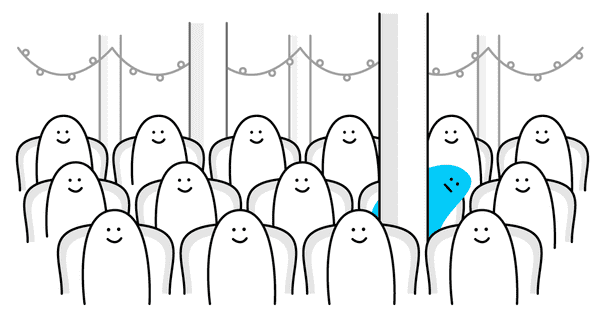This post is part of a series originally shared on togetherness.is, a people-first resource for gathering remotely.
- Togetherness
- Sit in the bad seats (You are here)
- Have your passports ready
- Give your attendees the wheel
- Recommended resources

You can have the most incredible programming, and the perfect group of people, but if the chairs are uncomfortable or sight lines are compromised, you’ll lose people.
This is both literally true and a metaphor.
When we had finished setting up our ambitious three-day musical theatre and JavaScript training experience, JS for Teams: “It’s ALIIIIIIIVE!”, one of our team said members, “Hold on, let’s do one last thing.”
The team went around the room and sat in every seat, gauging the quality of the experience from different vantage points. The team spent extra time sitting in what they’d discerned were the worst seats. Once they’d gotten a feel for how the people in those seats were going to experience the event, the team changed the whole setup of the room.
The event is only as good as it feels from the worst seats. People shouldn’t have to luck into a good seat to have the best possible experience.
This is every bit as true in a remote context. You may not be able to control the kind of chairs your participants are sitting in, but you can:
- spend some time thinking about how the experience will feel from the equivalent of “the nosebleed section”: low bandwidth, small screen, home office, etc.
- send out a list of recommendations for optimizing their experience — what would make it easier for people to have the equivalent of a good view, a comfortable seat, a place to settle in?
- allow time at the beginning of the event to walk people through any adjustments they can make, to have a more comfortable, rich, immersive experience.
- think about what their different ‘seats’ might be and ask about the experience from that perspective, like: “What will the experience be for people who are going to be distracted because they’re also caring for kids?”
- do everything in your power to make your event as accessible as possible – think live captioning, clear descriptions for visual content, written transcripts/shared notes, and so on.
A bad chair decision can ruin your whole event — and that’s not hyperbole. We once neglected to test a venue’s gorgeous wood chairs thoroughly; the chairs created beautiful, clean, modern lines in the room, and they seemed fine at first. But after thirty minutes of sitting on them, it became apparent that the seats were so flat and uncomfortable that some people’s legs had fallen asleep. The chairs became a distraction, and detracted significantly from everyone’s enjoyment and ability to focus.
That was an utter seating failure — though in retrospect, it was probably the seed of how we ended up with only couches and comfy chairs at &yetConf.
For us, “sit in the bad seats” signifies a bunch of related, crucial, and often overlooked things:
- The basics matter more than you think. Nourishing snacks, good water, comfortable seating, the temperature of the room — they all contribute significantly to your event’s success.
- Make sure every seat is a good seat. Use whatever factors are in your control to ensure everyone in attendance is having the best possible experience.
- Sometimes the literal is the best path to the figurative. Want to put yourself in your attendees’ shoes? Try sitting in their actual seats.
Check out the next post in the Togetherness series: Have your passports ready.